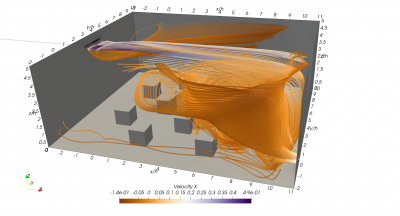Viral Fate & Transport for COVID-19

Domain/mesh for a staggered elementary school classroom (the cubes denote student units which are desk+chair+student). In a typical setting, flow comes in from a HVAC duct on the left wall and goes out a door on the right wall.
Investigator: Ramesh Balakrishnan
Affiliation: Argonne National Laboratory
Funding: DOE Office of Biological and Environmental Research
Potentially infectious sites are created when COVID-19 carrying aerosol particles are released as a person talks/sings/coughs/sneezes/breathes and the virus is deposited on the ground and other surfaces. This team is studying how this process occurs in a model classroom setting.
Simulations are carried out by the highly scalable spectral element code, Nek5000, that has been tuned to run on Intel KNL platforms like NERSC’s Cori. The team is using large eddy simulations (LES) of the turbulent flow with aerosol particles to study the dispersion and deposition of the aerosols. The calculations simulate a classroom using about 1 billion grid points and 100K to 250K aerosol particles.
About NERSC and Berkeley Lab
The National Energy Research Scientific Computing Center (NERSC) is a U.S. Department of Energy Office of Science User Facility that serves as the primary high performance computing center for scientific research sponsored by the Office of Science. Located at Lawrence Berkeley National Laboratory, NERSC serves almost 10,000 scientists at national laboratories and universities researching a wide range of problems in climate, fusion energy, materials science, physics, chemistry, computational biology, and other disciplines. Berkeley Lab is a DOE national laboratory located in Berkeley, California. It conducts unclassified scientific research and is managed by the University of California for the U.S. Department of Energy. »Learn more about computing sciences at Berkeley Lab.







